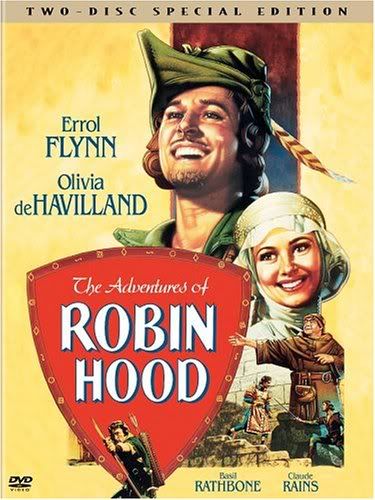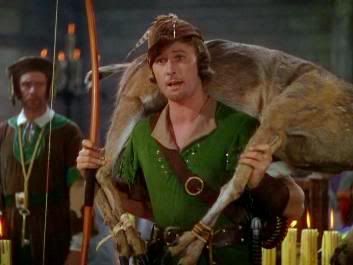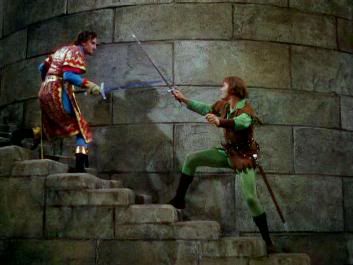
[audio:http://www.blueinkalchemy.com/uploads/robinhood.mp3]
Long before things like 3-D, CGI, THX and all those other wonderful acronyms came along, films were seen as extensions of the stage. Actors brought their best Shakespearean bombast, sets were designed as you would the sort of staging you’d have to quickly break down in the dark between acts, and directors framed and propelled their shots in a particular way. If 1938’s classic swashbuckler The Adventures of Robin Hood has a flaw, that’d probably be the biggest one. It’s also completely irrelevant, however, as this is the sort of movie where I can use the words ‘classic swashbuckler’ with an entirely straight face.

King Richard I of England is on his way back from the Crusades when he gets tied up in Austria. Literally. Some guy named Leopold takes him prisoner. Richard’s little brother John takes over and immediately starts oppressing the Saxon commoners, fattening the purses of the Norman land-holders to build up support for his bid for England’s throne. The big thorn in John’s side is the Saxon Robin, Earl of Locksley, who sees right through John’s public decrees that the increased taxes are to pay Richard’s ransom and vows to do everything in his power to stop the oppression and restore Richard to his throne. Sir Guy of Gisbourne, John’s aide de camp, makes a vow of his own, which is to see Robin dangling from the end of a rope, especially when the lovely Maid Marian starts warming to Robin’s roguish charm instead of falling for Guy’s Norman sensibilities and position. There’s plenty of sword fighting, swinging from ropes, and the sort of laughs men make by putting their hands on their hips and engaging their diaphragms.
As I said, this is a classic swashbuckler. The classic part of that comes from the Oscar-winning score and art direction, as well as the acting. The story isn’t all that original but it’s being told with such adventurous abandon and honest charm that the premise never gets in the way of the fun. Sure, the sets look a bit two-dimensional in places, the lighting isn’t always appropriate for the fictional time of day or night and there’s more than enough men in green tights on display to give Mel Brooks something to parody, but in the case of this Robin Hood it’s easy to brush all of that aside. The way in which this movie is acted, shot and presented is so rousing, colorful, lighthearted and satisfying that it could have been shot in the round against a black background and it’d still be entertaining.

“So, I heard you like venison…”
Errol Flynn in particular possesses so much charisma and wit that it’s obvious why he became the iconic Robin Hood for years. He takes a film with a setting, story and style that would normally mark it as charmingly camp, and elevates it to being just plain charming. He has chemistry with Olivia de Havilland, who manages to look glamorous even when she’s wearing some pretty ridiculous headgear. By this point they’d already worked together on two pictures, one of which being the equally iconic Captain Blood which also paired Flynn with one Basil Rathbone.
This is one of the earliest instances I can recall of seeing a main villain who keeps their hands clean while a top lieutenant does the dirty work with relish – a Big Bad and a Dragon, if you will. In Robin Hood, Claude Rains and Basil Rathbone demonstrate exactly how this dynamic should work. Rains’ Prince John is affable, magnanimous, crafty and ruthless all at the same time, and while he never becomes physically involved in the goings-on, his presence is undeniable. Rathbone’s Sir Guy, on the other hand, has little patience for posturing and politics, spending most of his time waiting for Prince John to tell him who he gets to stab next. Long before things like powered armor or automatic weapons were born, Basil Rathbone used tone, poise and expression to show audiences exactly what it means to be the biggest badass in the room.

Prince John’s “WAT.” face
There’s even a touch of a villainous Power Trio, with Melville Cooper’s somewhat rotund and cowardly Sheriff of Nottingham revealing himself to be a pretty smart guy. However, the most interesting relationship is that between Robin and Sir Guy. These are two men who are completely confident in their own abilities, are vying for the affections of the same woman and serve two entirely different masters. Underneath the story stuff, however, is the chemistry between Errol Flynn and Basil Rathbone. It’s particularly telling in their swordplay, which segues me into the ‘swashbuckling’ portion of this ‘classic swashbuckler.’
The swordfights that happen in Robin Hood are fun to watch, with high energy and great music underscoring the tension. The movements are large and deliberate, swords clash against one another and the hero and villain exchange blows on spiral stairs, or wander out of shot for their shadows to do the dueling. This is the textbook example of well-choreographed cinematic swordplay, even if trying to engage someone in a sword fight in real life using these techniques would quickly get one skewered. It’s the kind of swordplay that makes films like the aforementioned Captain Blood, 1940’s The Sea Hawk and The Princess Bride such swashbuckling classics – and those are good examples of how these fights are staged, a method sometimes referred to as Flynning. Guess why.

“But enough talk! Have at you!”
This isn’t to say that it looks terribly fake. Outside of the occasional set or lighting error, Robin Hood looks great all around. While the costuming’s probably not terribly historically accurate, it’s quite sumptuous and atmospheric, and being shot in Technicolor, everything’s got a bit of a bright sheen on it. And while the aforementioned sword fights aren’t necessarily realistic, they don’t look bad at all, either. Hell, Basil Rathbone was an accomplished fencer as well as a great actor, and he used his skill to make sure he let Errol Flynn have a convincing win!
Whups, sorry, should’ve put a spoiler alert on that one.
Anyway, The Adventures of Robin Hood is a classic that might show its age in places, but has definitely aged gracefully. It’s exciting and fun to watch without being dumb or terribly formulaic, which is more than can be said for a lot of films being made some 70 years later. The cast is charming, the action is well done and the story, while familiar, is told with enough touches of freshness that it’s still interesting after repeated viewings. I say give it a look. If you have already seen it, I have to ask this one question: Where the hell did the phrase “lusty infant” come from?
Josh Loomis can’t always make it to the local megaplex, and thus must turn to alternative forms of cinematic entertainment. There might not be overpriced soda pop & over-buttered popcorn, and it’s unclear if this week’s film came in the mail or was delivered via the dark & mysterious tubes of the Internet. Only one thing is certain… IT CAME FROM NETFLIX.


